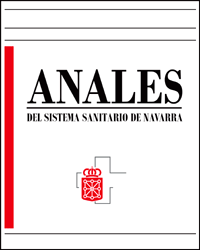Características demográficas del síndrome de Down en Navarra. Evolución del diagnóstico pre y postnatal durante el periodo 1991-2009
Palabras clave:
amniocentesis, diagnóstico prenatal, cobertura, cribado, demografía, síndrome de DownResumen
RESUMEN
Fundamentos y objetivo: Navarra inició en 1991 un proyecto centralizado de prevención de síndrome de Down (SD) basado en el asesoramiento genético y el cariotipo fetal en gestaciones de alto riesgo. Este estudio describe la evolución del diagnóstico pre y postnatal del SD durante 19 años y analiza su impacto preventivo y los cambios demográficos asociadas.
Material y métodos: Análisis descriptivo de los datos de los programa de cribado y diagnóstico antenatal del SD, nacimientos totales y niños nacidos con SD en Navarra desde 1991 a 2009.
Resultados: El cambio en la edad materna desde 1991 a 2009 hubiera conllevado un aumento del 50% en el número de nacimientos con SD. Sin embargo, el incremento de la tasa de detección prenatal (13,2% durante 1991-1994 y 60% entre 2006-2009) ha condicionado un descenso de su incidencia y un aumento en la edad media de sus madres (33,5 y 35,1 años en el primer y último periodos, respectivamente). El porcentaje de nacimientos con SD, hijos de madres jóvenes, disminuyó del 66% (1991-2004) al 45% (2006-2009). Casi un 25% de las gestantes rechazaron el cribado bioquímico o la amniocentesis y un 17% de los nacimientos con SD tuvieron un resultado de cribado positivo, pero las madres decidieron continuar el embarazo.
Conclusiones: A pesar de implementar nuevos métodos más sensibles de cribado, la incidencia del SD puede mantenerse relativamente alta en Navarra, circunstancia a tener en cuenta tanto en la elaboración de planes de prevención antenatal como de los de su cuidado postnatal.
SUMMARY
Background and aims: The Autonomous Community of Navarra started in 1991 a centralized preventive program for Down´s syndrome (DS), based on genetic counselling and fetal karyotype in high risk pregnancies. This paper describes the trends of antenatal and postnatal diagnosis of DS during a period of 19 years, and assesses its preventive impact in the population and the associated demographic changes.
Materials y methods: A descriptive analysis of data on maternal screening and prenatal diagnosis programs for DS, total births and births with DS in Navarra from 1991 to 2009.
Results: The change in maternal age from 1991 to 2009 would have caused a 50% increase in births with DS. However, antenatal rate detection of DS increased from 13,2% in 1991-4 to 60% in 2006-9, giving rise to a decreasing incidence trend during the study period and to a higher mean age of their mothers (33,5 y 35,1 years during the first and second periods of the study, respectively). The proportion of young mothers of newborn with DS was 66% in 1991-4 and 45% in 2006-9. Close to 25% of pregnant women did not uptake maternal screening test or amniocentesis. Of the total live births with DS, 17% had a positive screening test, but mothers decided to continue pregnancy.
Conclusions: Despite the application of more sensible screening tests, the incidence of DS may still be relatively high in Navarra, an important factor to be considered for future antenatal preventive programs and the adequate postnatal care.
Descargas
Citas
1. SAVVA GM, MORRIS JK, MUTTON DE, ALBERMAN E. Maternal age-specific fetal loss rates in Down syndrome pregnancies. Prenat Diagn 2006; 26: 499-504.
https://doi.org/10.1002/pd.1443
2. CUCKLE HS, HOLDING S, JONES R, GROOME NP, WALLACE EM. Combining inhibin A with existing second-trimester markers in maternal serum screening for Down's syndrome. Prenat Diagn 1996; 16: 1095-1100.
https://doi.org/10.1002/(SICI)1097-0223(199612)16:12<1095::AID-PD997>3.0.CO;2-9
3. BENACERRAF BR, NEUBERG D, BROMLEY B, FRIGOLETTO FD JR. Sonographic scoring index for prenatal detection of chromosomal abnormalities. J Ultrasound Med 1992; 11: 449-458.
https://doi.org/10.7863/jum.1992.11.9.449
4. BALL RH, CAUGHEY AB, MALONE FD, NYBERG DA, COMSTOCK CH, SAADE GR et al. First and Second Trimester Evaluation of Risk (FASTER) Research Consortium. First- and second-trimester evaluation of risk for Down syndrome. Obstet Gynecol 2007; 110: 10-17.
https://doi.org/10.1097/01.AOG.0000263470.89007.e3
5. DOLK H, LOANE M, GARNE E, DE WALLE H, QUEISSER-LUFT A, DE VIGAN C et al. Trends and geographic inequalities in the prevalence of Down syndrome in Europe, 1980-1999. Rev Epidemiol Sante Publique 2005; 53, 2: 2S87-95.
https://doi.org/10.1016/S0398-7620(05)84771-6
6. COCCHI G, GUALDI S, BOWER C, HALLIDAY J, JONSSON B, MYRELID A et al. International trends of Down syndrome 1993-2004: Births in relation to maternal age and terminations of pregnancies. Birth Defects Res A Clin Mol Teratol 2010; 88: 474-479.
https://doi.org/10.1002/bdra.20666
7. MUGGLI EE, MCCLOSKEY D, HALLIDAY JL. Health behaviour modelling for prenatal diagnosis in Australia: a geodemographic framework for health service utilisation and policy development. BMC Health Serv Res 2006; 6: 109.
https://doi.org/10.1186/1472-6963-6-109
8. Descripción del estado de situación del cribado prenatal de las cromosmopatías más frecuentes -principalmente del síndrome de Down- en el Estado Español y propuestas de mejora en la práctica clínica habitual. Informes de Evaluación de Tecnologías Sanitarias AATRM Num. 2006/03.
9. Orden Foral 56/2006. B.O. de Navarra de 29 de mayo (publicado el 21 de Julio de 2006).
10. MORRIS JK, MUTTON DE, ALBERMAN E. Revised estimates of the maternal age specific live birth prevalence of Down's syndrome. J Med Screen 2002; 9: 2-6.
https://doi.org/10.1136/jms.9.1.2
11. MORRIS JK, ALBERMAN E. Trends in Down's syndrome live births and antenatal diagnoses in England and Wales from 1989 to 2008: analysis of data from the National Down Syndrome Cytogenetic Register. BMJ 2009; 339: b3794.
https://doi.org/10.1136/bmj.b3794
12. EGAN JF, BENN PA, ZELOP CM, BOLNICK A, GIANFERRARI E, BORGIDA AF. Down syndrome births in the United States from 1989 to 2001. Am J Obstet Gynecol 2004; 191: 1044-1048.
https://doi.org/10.1016/j.ajog.2004.06.050
13. RESTA RG. Changing demographics of advanced maternal age (AMA) and the impact on the predicted incidence of Down syndrome in the United States: Implications for prenatal screening and genetic counseling. Am J Med Genet A 2005; 133A: 31-36.
https://doi.org/10.1002/ajmg.a.30553
14. KHOSHNOOD B, DE VIGAN C, VODOVAR V, GOUJARD J, GOFFINET F. A population-based evaluation of the impact of antenatal screening for Down's syndrome in France, 1981-2000. Bjog 2004; 111: 485-490.
https://doi.org/10.1111/j.1471-0528.2004.00117.x
15. VERLOES A, GILLEROT Y, VAN MALDERGEM L, SCHOOS R, HERENS C, JAMAR M et al. Major decrease in the incidence of trisomy 21 at birth in south Belgium: mass impact of triple test? Eur J Hum Genet 2001; 9: 1-4.
https://doi.org/10.1038/sj.ejhg.5200575
16. WEIJERMAN ME, VAN FURTH AM, VONK NOORDEGRAAF A, VAN WOUWE JP, BROERS CJ, GEMKE RJ. Prevalence, neonatal characteristics, and first-year mortality of Down syndrome: a national study. J Pediatr 2008; 152: 15-19.
https://doi.org/10.1016/j.jpeds.2007.09.045
17. MOSQUERA TENREIRO C, ARIZA HEVIA F, RODRIGUEZ DEHLI C, FERNANDEZ TORAL J, GARCÍA LÓPEZ E, RIANO GALAN I. Frecuencia del síndrome de Down en Asturias y tendencia temporal, 1990-2004. Med Clin (Barc) 2009; 132: 580-584.
https://doi.org/10.1016/j.medcli.2008.10.052
18. BERMEJO E, CUEVAS L, MENDIOROZ J, GRUPO PERIFÉRICO DEL ECEMC, MARTÍNEZ-FRÍAS ML. Frecuencia de anomalías congénitas en España: Vigilancia epidemiológica en el ECEMC en el período 1980-2007. Boletín del ECEMC: Revista de Dismorfología y Epidemiología, serie V, nº 7, 2008: 59-88.
19. NICHOLSON A, ALBERMAN E. Prediction of the number of Down's syndrome infants to be born in England and Wales up to the year 2000 and their likely survival rates. J Intellect Disabil Res 1992; 36 (Pt 6): 505-517.
https://doi.org/10.1111/j.1365-2788.1992.tb00569.x
20. GIDIRI M, MCFARLANE J, HOLDING S, LINDOW S. Maternal serum screening for Down syndrome: are women's perceptions changing? Bjog 2007; 114: 458-461.
https://doi.org/10.1111/j.1471-0528.2007.01266.x
21. DIXON J, PILLAI M, MAHENDRAN D, BROOKS M. An assessment of the Down syndrome antenatal screening policies of East and West Gloucestershire between 1993 and 1999. J Obstet Gynaecol 2004; 24: 760-764.
https://doi.org/10.1080/014436104100009444
22. GIRIDI M, HOLDING S, LINDOW SW. Reduction in Down syndrome screening acceptance is predominantly observed in women aged 25-35 years. Women's Health 2010, 6: 525-529.
Archivos adicionales
Publicado
Cómo citar
Número
Sección
Licencia

Esta obra está bajo una licencia internacional Creative Commons Atribución-CompartirIgual 4.0.
La revista Anales del Sistema Sanitario de Navarra es publicada por el Departamento de Salud del Gobierno de Navarra (España), quien conserva los derechos patrimoniales (copyright ) sobre el artículo publicado y favorece y permite la difusión del mismo bajo licencia Creative Commons Reconocimiento-CompartirIgual 4.0 Internacional (CC BY-SA 4.0). Esta licencia permite copiar, usar, difundir, transmitir y exponer públicamente el artículo, siempre que siempre que se cite la autoría y la publicación inicial en Anales del Sistema Sanitario de Navarra, y se distinga la existencia de esta licencia de uso.








